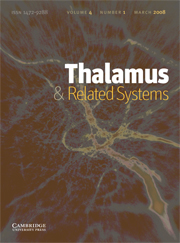No CrossRef data available.
Article contents
Might deep brain stimulation of the subthalamic nucleus be neuroprotective in patients with Parkinson’s disease?
Published online by Cambridge University Press: 18 April 2006
Abstract
Parkinson’s disease (PD) is characterized by nigral degeneration of dopaminergic neurons in the pars compacta of the substantia nigra. Rather than treating only the symptomatic aspects of Parkinson’s disease, one may also consider treatments designed to retard, arrest, or even reverse this degenerative process. Such strategies could include preventive or restorative treatments instead of purely palliative treatments. A recent hypothesis states that glutamate output from the subthalamic nucleus (STN) to the substantia nigra contributes to the neurotoxic process underlying dopaminergic cell death in Parkinson’s disease. Furthermore, high-frequency stimulation (HFS) of the STN inhibits neurons resulting in the suppression of their glutamate output. Experiments in both rats and monkeys provide preliminary data supporting this hypothesis. Kainic acid (KA) lesions of the STN prevent the loss of dopaminergic neurons in the substantia nigra after intrastriatal injection of 6-hydroxydopamine (6-OHDA) in rats, and after systemic administration of MPTP in monkeys. In PD patients, the background level of their disease is evaluated in the off medication/off stimulation state (UPDRS III score), over a period of 5 years. Thirty percent of the patients are stabilized and 18% have persistent improvement of their disease-related impairment. Further experiments are needed, including controlled clinical trials utilizing functional imaging of the dopamine transporters and post-synaptic receptors.
Keywords
Information
- Type
- Research Article
- Information
- Copyright
- Elsevier Science Ltd

